The Reina Regentes class cruisers were designed as an improvement of the Alfonso XII, with some protection (they were the second class of Spanish protected cruisers after the small Isla de luzon group). Instead of being designed and built in Spain, the Government sent a delegation to Britain to explore the latest designs of the time, and somewhat took inspiration from the Orlando class but were designed by John H. Biles at Thompson Yard. The first of these was to be built in UK, ordered in Glasgow, Scotland, and the two others, with purchased plans and advisors, built in Spain at Ferrol and Cartagena.
If Reina Regentes was built in two years, the much heavier guns installed cause probably her capsizing, leading to modify the two others, Alfsonso XIII and Lepanto. They took between 6 and 13 years to completion, and were only commissioned after many modification, still leavibng muych to be desired. By the time they entered service, they were hopelessely obsolete, woefully inadequate and riddled with issues, and had a fairly short career. Needless to say they took no part in the 1898 war, Reina Regentes foundered in a storm in 1895 and Lepanto was still months beyond completion, ending as a training ship straight away. In WWI a Spanish cruiser was named Reina regentes, but this a brand new (and this time more successful design) launched in 1906.
Design of the class
Origin
The history of the Reina Regente started in 1885 as the Spanish Government commissioned James and George Thompson and Co. (after 1899 John Brown and Co.) to build a protected cruiser following designs of contemporary British warships, and as a model for two ships to be built in Spain. The ship was designed by Sir John H. Biles, recoignised as a very successful engineer, professor of naval architecture at the University of Glasgow, with Sir Nathaniel Barnaby acting as supervisor and one of the best experts in British naval design at the time. The starting point of the Reina Regente design was a compromise between a small hull and powerful armament, powerful machinery and great radius of action as requested by Spain. Some of the most advanced concepts of the time were emplotyed such as triple expansion steam engines on two shafts, but construction decisions were adopted with some unknowns (the main arament weight) which will have unforeseeable consequences given the knowledge of the time.
The final design was fixed to 4,600 tons, and integrated a protective deck while their hull had many compartments holding enough coal to reach 12,000 miles on paper. For colonial cruisers, this was excellent, and subsequentely they would not need a rigging. They were the first steam-only cruisers of the Spanish Navy. The main armament was initially even more powerful than the Alfonso XII class, and placed high up on superstructures, instead of sponsons.
Development
The general principle of these cruisers was an “update” of Spanish designs and construction practices as many in the Navy feared that the colonial masted cruisers built until then, the Alfonso XIII, Isla de Luzon (so small they were re-rated as gunboats by the US after capture), Velaco and Aragon class in all 17 unprotected or lightly protected cruisers, quite a sizeable force on paper, would be hopeless in case of war. Thus, a brand new design by Reed in UK was preferred, the first built there and the two others in Spain. The problem was the yard’s organization and bottlenecks which led to extremely long construction delays, five years for Alfonso XII in Ferrol and …thirteen years for Lepanto in Cartagena.
These were the first Spanish cruisers with twin turrets as main artillery placed in pairs high up, which was a source of topweight and probable cause of the loss of Reina Regentes, as the British design came out with no guns ate all, later to be the 280 mm González Hontoria in a truangle pattern, one aft, two forward, much heavier than anticipated.
Flawed design seeing almost no service

The other two ships underwent many changes to avoid this top weight problems, but that affected their top speed, seaworthiness and a weaker armament. Not only they encountered many delays due to thies redesigns, but also they accumulated such a number of defects that they were systematically rejected for acceptance, and in the end, gave no satfiscation, havbing little service and not used a flotilla leaders as initially expected. Alfonso XIII was retired only two years after her entry into service and Lepanto became a training ship straight away, never taking part in fleet actions.
In 1900, May 18 the Ministry of the Navy decreted that they would be decommissioned, alongside with 25 other ships seein of little value. The explanation for the Alfonso XIII was as following:
Alfonso XIII is a very imperfect ship similar to the unfortunate Reina Regente, without any vertical protection, only a light protective deck, lacking stability, with poorly mounted engines, a top speed of just 12 miles, it being the general opinion of the technical authorities of the Navy that this ship should not sail, at least without large and costly modifications so as not to expose its crew to a probable disaster, and should only be seen as an impediment and obstacle for any squadron or naval division, nor being able to be applied either to defensive actions or to peace commissions, for which there are already sufficient ships in proportion to the means that a reasonable budget of naval forces must apply for each service.
Hull and general design
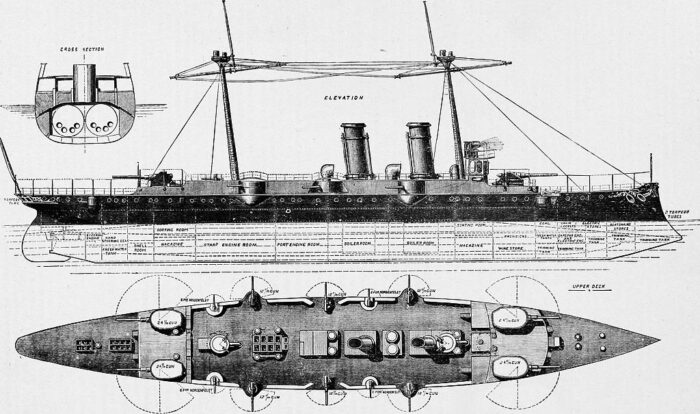
These cruisers were of the same size, and larger than the previous Alfonso XIII: They displaced 4,725 ton versus 3042t, quite a massive increase, for greater dimensions overall at 96.62 metres (317 ft) long, for a beam of 15.24 metres (50 ft) and mean draft of 6.21 metres (20 ft 4 in) compared to 84.82 x 13.22 meters in length and beam.
They also shared their general appearance with the contemporary USS Olympia in the USN ironically, rather than the Alfonso XII. The latter had a relatively tall hull with a clipper stern, limited ram bow with forecastle, tall bulwarks and three masts with full rigging.
Apart their two tall funnels amidships, the Reina Regentes could not be more different, with a lower fulsh deck hull without bulwarks, pronounced bow, a much more developed superstructure with two military masts and reduced rigging (it was never fitted in practice) and the bridge relocated in front of the mainmast. Both steel masts were raked and supported each a spotting/weapon station.
For the armament also, it was a radical departure, with lighter but more modern and faster guns, partly in sponsons and in shielded positions on deck.
And there was a protection which did not exist on previous cruisers, hence their classification, albeit symbolic.
Powerplant
Each cruiser was fitted with two shafts and four bladed screw propellers, driven by two Thompson triple expansion reciprocating engines (VTE), fed in turn by four cylindrical boilers. This powerplant was rated for 11,500 nhp (8,600 kW). To compare, the 1880s Alfonso XII had an antiquated single shaft compound arrangement rated for 4,400 ihp. Conversely, speed was radically superior, 20.4 knots (37.8 km/h) at forced draught versus 17 knots. Being larger they also carried more coal, 1200t instead of 500t and range was considerably higher at 7200 nautical miles at 10 knots cruise speed.
Armament
The armament was very powerful wth a main artillery consisting of four González Hontoria model 1883 240 mm L/35 cannons mounted in pairs on the upper deck, two forward and two aft. They also had six individually mounted 120 mm González Hontoria L/35 as medium calibre in the lower battery deck sponsons, and behind bulwarks, three port and three starboard. Light armament commrised six 57 mm Nordenfelt guns and several machine guns ad well as five 356 mm torpedo tubes, one forward, two either beam underwater.
González-Hontoria 240 mm/35
These initial guns were protected with 76 mm shields and could fire 199 kgs shells to a maximum range of 9,960 meters. 240 mm meant they were quite hefty and certainly extremely heavy to be mounted on top of the superstructure in Spain. No doubt they constituted a massive top weight issue, that was probably observed already in early years, notably excessive rolling.
The exact specs and performances of the González-Hontoria 240 mm/35 are unknown. Still hgave to find a Spanish source detailed these. The position of these guns meant at some angles the opposite guns could fire cross-deck; so making for a four guns broadside at some limited angles. However the concussion alone so close to the opposite gun crews was probably more than discutable…
120 mm/35 González Hontoria model 1883
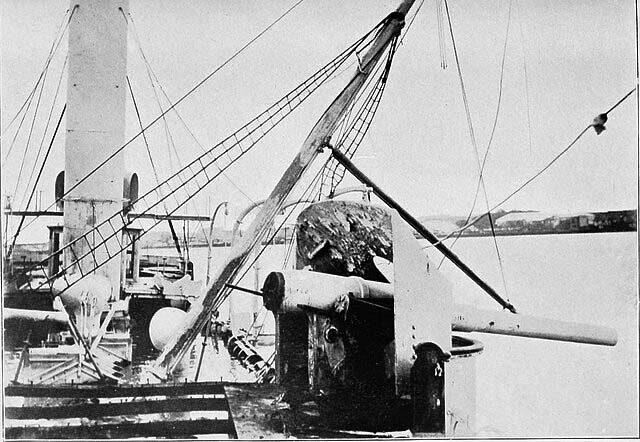
These better known 4.7 inches guns came out with 25 mm thick armoured shields and could fire a 24.1 kg (53 lb) shell at a maximum range of 10,130 meters, more than the main guns…
They used separate loading with 13 kg (29 lb) smokeless powder bagged charge, using an Interrupted screw breech. Muzzle velocity was 612 m/s (2,010 ft/s) and amx range 10 km (6.2 mi) at +25°
Nordenfelt MGs
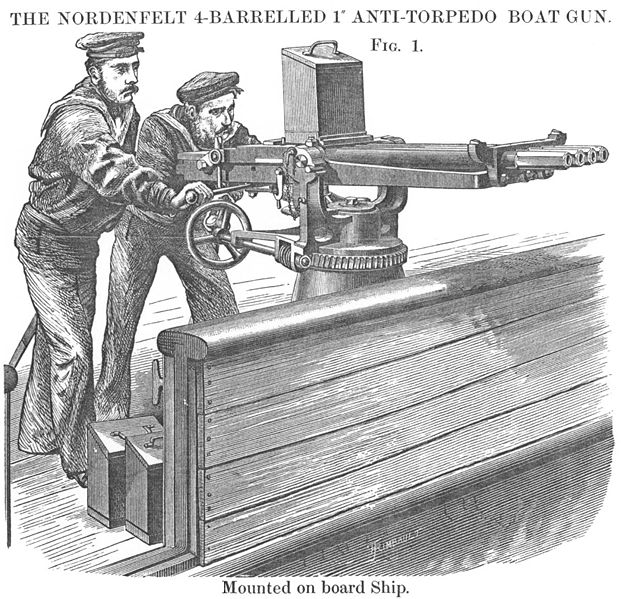
There were two at the poop, one on each spotting top, the rest on the upper deck, exact location unknown.
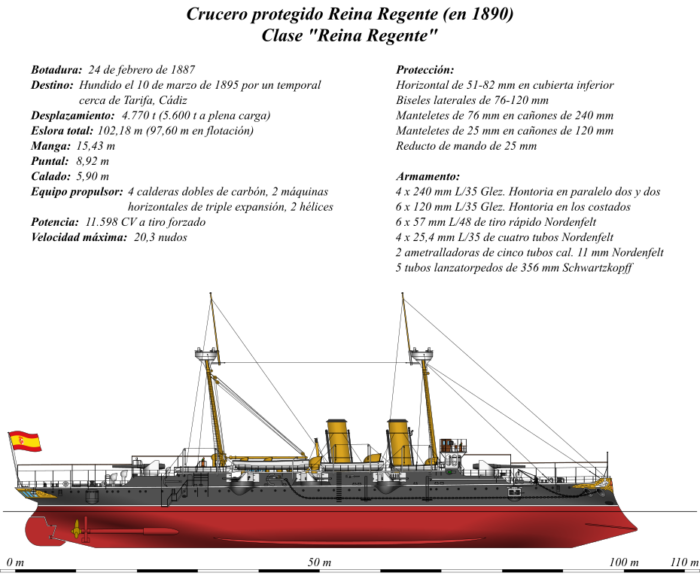
Reina Regentes 1890 by Erlenmeyer, wikimedia CC

Author’s old illustration
⚙ Alfonso XIII/Lepanto specifications |
|
| Displacement | 4,725 tons |
| Dimensions | 97.3 x 15.4 x 8.92m (319 ft 3 in x 50 ft 6 in x 29 ft 3 in) |
| Propulsion | 2 shafts VTE engines, 6? Boilers, 15,000 ihp |
| Speed | 20.5 knots (38.0 km/h; 23.6 mph) |
| Range | 500-750t coal, Steam unknown, sail unlimited |
| Protection | 3 in (7.6 cm) turret, 3.13 in (8.0 cm) deck |
| Armament | 4x 200mm/35 H M1883, 6x 119 mm/35 H M1883, 6x 57mm/42 N, 2 MGs, 5 TTs |
| Crew | 420 |
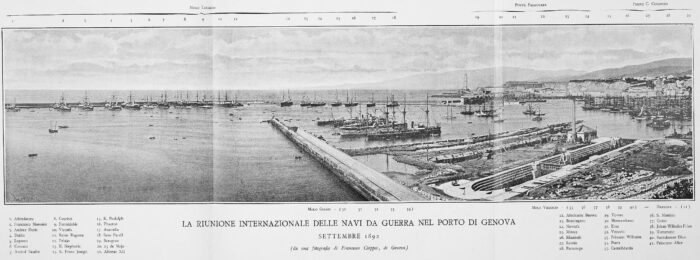
Various international ships at Genoa for a review, including the Spanish cruisers.
Career of the Reina Regentes class
 Reina Regentes (1887)
Reina Regentes (1887)
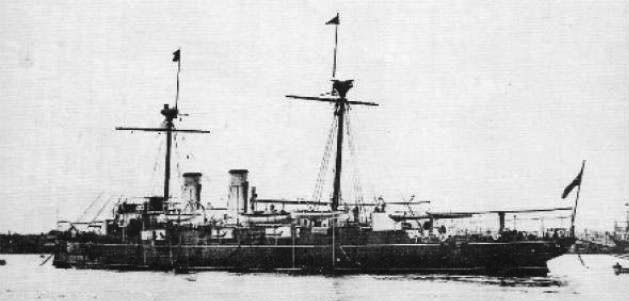
Reina Regente in 1890
Reina Regente was the first cruiser of her class, laid down on 20 June 1886, launched on 24 February 1887 at J&G Thomson of Govan, completed on 1 January 1888 as Reina Regente, named after Maria Christina, queen of Spain, and queen regent during her son’s Alfonso XIII minority. She had a short career from 1888 until her loss in 1895.
In September 1892, she sailed to Genoa as part of the Training Squadron for the celebrations of the IV Centenary of the Discovery of America as the home city of Cristopher Columbus (Cristoforo Colombo/Cristobal Colon). In April 1893 she left for Havana to collect a replica of the ship Santa María and tow it to Hampton Roads, for the same celebration in the US and an international naval review.
On 10 March 1895, Reina Regente departed Tangier in Morocco for Cádiz, Spain, with a crew of 420, under command of Captain Francisco Sanz de Andino. He ordered this trip to witness the launching of the modern armored cruiser Carlos V in Cádiz the following day, despite an uncertain meteo, crossing the Strait of Gibraltar into the Gulf of Cádiz. However there she was struck by severe storm and went down with all hands. Since she was announced and overdue, a search was launched, hoping to find her still somewhere sheltered in an African port. But soon wreckage started to wash up on Tarifa and Algeciras shores, until one elements linked to the ship confirmed the trategy. It is estimated today she foundered somewhere in the Gulf of Cádiz but her current location is still unknown. She became a national disaster, one of the deadliest losses of the Spanish Navy.
Only days after her disappearance, the Minister of the Navy, José María Beránger, ordered by Royal decree on March 29, that frigate captain Fernando Villaamil and naval engineer José Castellote started a Report on probable causes of her loss, which was presented on February 5, 1896 at an extraordinary meeting of the full naval staff and minister, with captains and the Inspector of engineers. They all endorsed its conclusions.
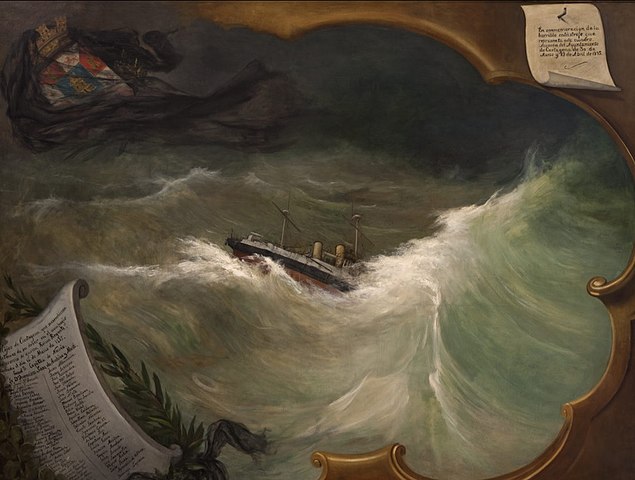
Commemorative painting of the loss of Reina Regentes, Prado.
The report came out with numerous calculations and assessed different alternatives: Collision with another ship, collision or grounding with a reef or shoal on the coast, lack of stability in rough sea conditions and all sorts of damages that would make her lose her seaworthy condition. As there were testimonies from fishermen and other vessels in their reports on a severe storm that day, it was likely that the crew was surprised and had not had time to close hatches and watertight doors, so at high speed, she would have taken on a large amount of seawater through her bow and port side, flooding decks and forward compartments. Once the engine room was flooded, left without steering she would have been tossed sideways and finally capsize.
The report by Villaamil and Castellote was published by the Ministry of the Navy and by 1896, the construction Alfonso XII and Lepanto was stopped altogether to give tim to reassess their design, causing a serie a delays and compromises as well as economic, material and administrative mishaps which doomed the surviving cruisers.
 Alfonso XIII (1891)
Alfonso XIII (1891)
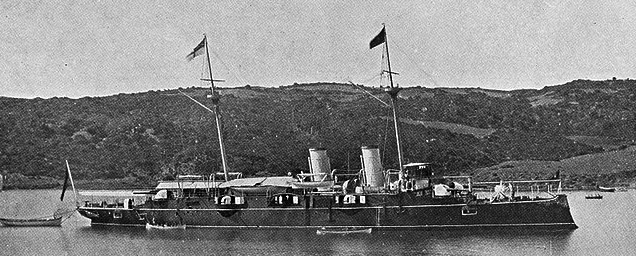
Alfonso XII in 1896 as completed
Alfonso XIII was built at Ferrol in Spain. Laid down in 1891, she was launched on 31 August 1891 and entered service in 1896 in a partially completed state, as training ship. She was finally fully completed and commissioned on 18 May 1900, but still, only entered service as a training ship. Still incomplete as the Spanish–American War commenced, she was sent to Cadiz on 7 May 1898, joining the reserve Spanish Navy’s 2nd Squadron under command of Rear Admiral Manuel de Camara which planned a reinforcement missioned to the Philippines. Camara departed while leaving behind Alfonso XIII on 16 June 1898, only to later abort the voyage when learning about the defeat at Manila. Alfonso XIII spent the rest of the war in Spanish waters as a coast defence ship from a potential USN attack. After the war, she was completed for good on 18 May 1900, commissioned the same day but given all her shortcomings, slow speed, poor protection, obsolete armament and poor seaworthiness this led her to a short career, so she was soon stricken and scrapped.
 Lepanto (1892)
Lepanto (1892)

Lepanto in the early 1900s in grey livery
Lepanto was the last cruiser of her class after Alfonso XIII and Reina Regente. She was laid down on 1 October 1886 and launched on 16 November 1893 at the Arsenal de la Cartagena on the Mediterranean coast. She was completed on 26 January 1899, named Lepanto after the shared Italian-Spanish battle against the Ottomans. Lepanto served from 1899 until her retirement in 1908 without any incident but as a training vessel only. She was ultimately scrapped in 1911, last surviving ship from her class.
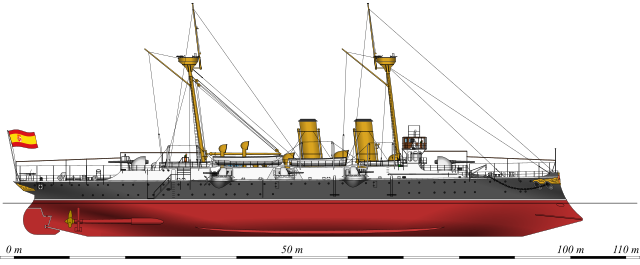
Lepanto as completed 1898 by Erlenmeyer, wikimedia CC
Lepanto had the longest construction of her class, affected by all kinds of technological difficulties. She had her sea trials in Cadiz on January 26, 1899, and only could reach 15 knots out of the 20 required. During the Spanish-American War, she was still not ready and despite listed as “active”, she was downgraded from a 1st class to a 2nd class cruiser, and from 1900 only used as a static Artillery and Torpedo School in Cartagena. The 200 mm Hontoria guns were unloaded, replaced by 160 mm from the ironclads Numancia and Vitoria in an attempt to improve stability. In a Royal decree by the MoN in 1900, May 18 she was part of the 25 units to be decommissioned for being considered ineffective.
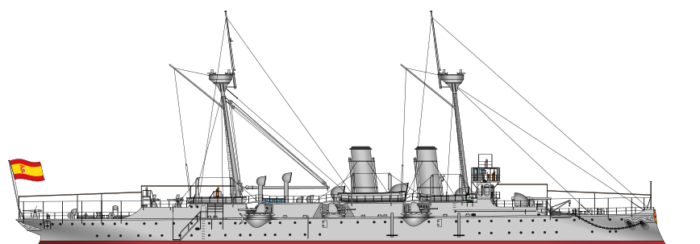
Lepanto 1908 by Erlenmeyer, wikimedia CC (cropped)
Art. 4. The School of Application or practice of Artillery, machines and torpedoes will be established on the cruiser Lepanto, concurring with the ships mentioned in the previous article in their special role, to the constant training of the personnel.
On April 8, 1907, she still escorted King Alfonso XIII, for his royal summit off Cartagena, with the British Empire’s king Edward VII.
In 1908, she towed the hull of the old gunboat Cocodrilo to Barcelon to be converted into an oceanographic research laboratory.
She was decommissioned on October 3, 1908, eight years after her commission, 22 years after her keel was laid down and sold for BU in 1911, scrapped in the Netherlands. Her name was given later to a destroyer.
Read More/Src
Links
https://www.wrecksite.eu/wreck.aspx?190461
http://www.navypedia.org/ships/spain/sp_cr_reina_regente88.htm
https://en.wikipedia.org/wiki/Reina_Regente-class_cruiser
https://en.wikipedia.org/wiki/Spanish_cruiser_Reina_Regente_(1887)
https://en.wikipedia.org/wiki/Spanish_cruiser_Lepanto
https://en.wikipedia.org/wiki/Spanish_cruiser_Alfonso_XIII

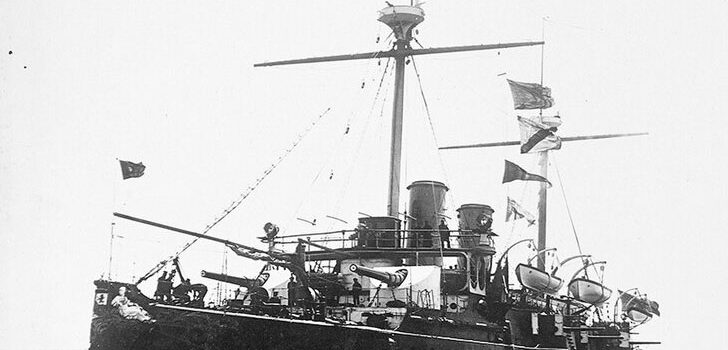

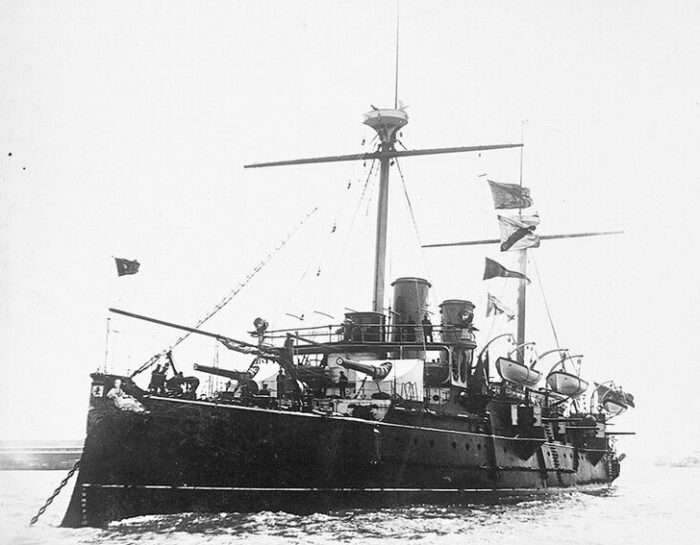
 Latest Facebook Entry -
Latest Facebook Entry -  X(Tweeter) Naval Encyclopedia's deck archive
X(Tweeter) Naval Encyclopedia's deck archive Instagram (@navalencyc)
Instagram (@navalencyc)





 French Navy
French Navy Royal Navy
Royal Navy Russian Navy
Russian Navy Armada Espanola
Armada Espanola Austrian Navy
Austrian Navy K.u.K. Kriegsmarine
K.u.K. Kriegsmarine Dansk Marine
Dansk Marine Nautiko Hellenon
Nautiko Hellenon Koninklije Marine 1870
Koninklije Marine 1870 Marinha do Brasil
Marinha do Brasil Osmanlı Donanması
Osmanlı Donanması Marina Do Peru
Marina Do Peru Marinha do Portugal
Marinha do Portugal Regia Marina 1870
Regia Marina 1870 Nihhon Kaigun 1870
Nihhon Kaigun 1870 Preußische Marine 1870
Preußische Marine 1870 Russkiy Flot 1870
Russkiy Flot 1870 Svenska marinen
Svenska marinen Søværnet
Søværnet Union Navy
Union Navy Confederate Navy
Confederate Navy Armada de Argentina
Armada de Argentina Imperial Chinese Navy
Imperial Chinese Navy Marinha do Portugal
Marinha do Portugal Mexico
Mexico Kaiserliche Marine
Kaiserliche Marine 1898 US Navy
1898 US Navy Sovietskiy Flot
Sovietskiy Flot Royal Canadian Navy
Royal Canadian Navy Royal Australian Navy
Royal Australian Navy RNZN Fleet
RNZN Fleet Chinese Navy 1937
Chinese Navy 1937 Kriegsmarine
Kriegsmarine Chilean Navy
Chilean Navy Danish Navy
Danish Navy Finnish Navy
Finnish Navy Hellenic Navy
Hellenic Navy Polish Navy
Polish Navy Romanian Navy
Romanian Navy Turkish Navy
Turkish Navy Royal Yugoslav Navy
Royal Yugoslav Navy Royal Thai Navy
Royal Thai Navy Minor Navies
Minor Navies Albania
Albania Austria
Austria Belgium
Belgium Columbia
Columbia Costa Rica
Costa Rica Cuba
Cuba Czechoslovakia
Czechoslovakia Dominican Republic
Dominican Republic Haiti
Haiti Hungary
Hungary Honduras
Honduras Estonia
Estonia Iceland
Iceland Eire
Eire Equador
Equador Iran
Iran Iraq
Iraq Latvia
Latvia Liberia
Liberia Lithuania
Lithuania Mandchukuo
Mandchukuo Morocco
Morocco Nicaragua
Nicaragua Persia
Persia San Salvador
San Salvador Sarawak
Sarawak Uruguay
Uruguay Venezuela
Venezuela Zanzibar
Zanzibar Warsaw Pact Navies
Warsaw Pact Navies Bulgaria
Bulgaria Hungary
Hungary

 Bundesmarine
Bundesmarine Dutch Navy
Dutch Navy Hellenic Navy
Hellenic Navy Marina Militare
Marina Militare Yugoslav Navy
Yugoslav Navy Chinese Navy
Chinese Navy Indian Navy
Indian Navy Indonesian Navy
Indonesian Navy JMSDF
JMSDF North Korean Navy
North Korean Navy Pakistani Navy
Pakistani Navy Philippines Navy
Philippines Navy ROKN
ROKN Rep. of Singapore Navy
Rep. of Singapore Navy Taiwanese Navy
Taiwanese Navy IDF Navy
IDF Navy Saudi Navy
Saudi Navy Royal New Zealand Navy
Royal New Zealand Navy Egyptian Navy
Egyptian Navy South African Navy
South African Navy






























 Ukrainian Navy
Ukrainian Navy dbodesign
dbodesign